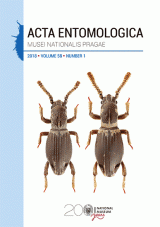Presence of uradenia in male adults of the genus Dismegistus (Hemiptera: Heteroptera: Parastrachiidae)
Pluot-Sigwalt Dominique, Lis Jerzy A.
Acta Entomologica Musei Nationalis Pragae 58(1): 187-193, 2018
Published online: 20th June 2018
Published in print: 15th August 2018
Views: 1447
Abstract: Uradenia, often referred to as paragenital glands, are usually voluminous paired
exocrine glands located ventrally in the abdomen mostly on the intersegmental
membrane between abdominal segments (= urites) VII–VIII or VIII–IX,
depending on sex or the taxon. They have been previously recorded from eight
pentatomomorphan families belonging to Coreoidea, Lygaeoidea and Pyrrhocoroidea
(Hemiptera: Heteroptera), found either in males, females or both sexes, and were
thought to be absent in Pentatomoidea. We report here the first instance of
uradenia in a pentatomoid genus, the African Dismegistus Amyot & Serville,
1843 (Parastrachiidae). Only the male adult possesses uradenia located on the
intersegmental membrane of segments VIII–IX. The only other genus of the
family, Parastrachia Distant, 1883, as well as other examined genera belonging
to pentatomoid families possibly related to Parastrachiidae (Cydnidae,
Thyreocoridae), do not possess uradenia. The uradenia of Dismegistus exhibit the
same fundamental structure as in other trichophoran families but differ by their
dorso-lateral position (instead of ventral), and also by the paired orifices
(instead of unpaired and median). The implications of the presence of uradenia
within member of a pentatomoid genus are briefly discussed.
Key words: Hemiptera, Heteroptera, Pentatomoidea, Parastrachiidae, Dismegistus, Parastrachia, morphology, abdominal segment VIII, ectodermal gland, uradenia
Papers
Review of the Anthelephila maindroni complex, and description of four new species from the Indian subcontinent (Coleoptera: Anthicidae)New and little known Jacobsoniidae (Coleoptera) from ChinaA new species of Platypelochares from Baltic amber (Coleoptera: Limnichidae)Significant range expansion for the rove beetle genus Deleaster, based on a new species from Papua New Guinea (Coleoptera: Staphylinidae: Oxytelinae)Lyalinus, a new genus of Cneorhinini from Burkina Faso (Coleoptera: Curculionidae)Trionymus okiensis sp. nov., a new species of mealybug from Japan (Hemiptera: Coccomorpha: Pseudococcidae)First Anthomyzidae (Diptera) from China: a new genus, six new species and new recordsTaxonomic revision of Pygodiscodon (Coleoptera: Cantharidae)Comparative genitalic morphology in ten genera of thread-legged bugs of the tribe Metapterini, and its phylogenetic importance (Hemiptera: Heteroptera: Reduviidae)Three new species and new records of cuckoo bees of the genus Epeolus in Turkey (Hymenoptera: Apidae: Nomadinae)A new species of Synopeas (Hymenoptera: Platygastridae) parasitizing Pauropsylla cf. depressa (Psylloidea: Triozidae) in IndiaDescriptions of Zygometapodus gen. nov. and a new species of Stenometapodus (Hemiptera: Heteroptera: Coreidae)A review of Scaphisomatini from Sulawesi, with descriptions of ten new species (Coleoptera: Staphylinidae: Scaphidiinae)Dolichogenidea maetoi sp. nov. (Hymenoptera: Braconidae) from Japan, the first parasitoid wasp recorded from Hyblaea fortissima (Lepidoptera)Elaphidiini (Coleoptera: Cerambycidae) from the Neotropical Region: new species, updated key, new synonym, and new recordsPresence of uradenia in male adults of the genus Dismegistus (Hemiptera: Heteroptera: Parastrachiidae)Larval morphology of Yateberosus, a New Caledonian endemic subgenus of Laccobius (Coleoptera: Hydrophilidae), with notes on ‘Berosus-like’ larvae in HydrophiloideaAnnotated catalogue of the flower bugs from India (Heteroptera: Anthocoridae, Lasiochilidae)Missing geographic link: minute lady beetles (Coleoptera: Coccinellidae: Microweiseinae) from Mount Wilhelm, New GuineaNotes on the Dianous luteoguttatus complex with description of a new species (Coleoptera: Staphylinidae)New species and first record of Helotrephes from India, and a check-list of Indian Helotrephidae (Hemiptera: Heteroptera)Four new species and new records of Manota (Diptera: Mycetophilidae) from Sulawesi, IndonesiaContribution to the knowledge of selected genera of the tribe Opsiini (Hemiptera: Cicadellidae: Deltocephalinae) from the Kingdom of Saudi ArabiaTwo new species of Heleomyzidae (Diptera) from Czech Republic and CrimeaA revision of the types of Heteroptera species described by Géza Horváth based on specimens from collections of Ladislav Duda and Emil Holub 